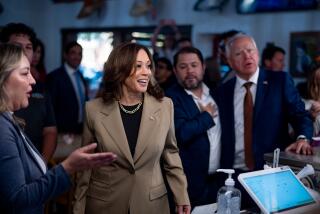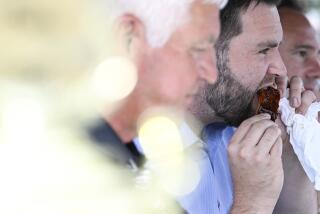The first suppers: A tradition of inaugural meals
Barack Obama will be sworn into office on Tuesday -- just weeks before the bicentennial of Abraham Lincoln’s birth. Obama’s inaugural theme, “A New Birth of Freedom,” has, fittingly, been drawn from his fellow Illinoisan’s Gettysburg Address, and he’s supposed to be sworn in using Lincoln’s own Bible. The inaugural menu is based on what supposedly were some of Lincoln’s favorite foods, and even the inaugural china is a replica of that used in the Lincoln White House. Despite these connections, let’s hope that Obama’s inaugural meal does not duplicate Lincoln’s first, which turned into a food fight.
Lincoln’s inaugural committee had planned a lavish midnight buffet for the inaugural ball: terrapin stew, leg of veal, beef à l’anglais, foie gras, pâté, cream candies, fruit ices, tarts, cakes and more. The venue was the Patent Office, which had two spacious halls for dancing and dining. The buffet was set out in a corridor where patent models were displayed.
When the grand supper was announced, after several hours of dancing, the crowd rushed the table and people began grabbing, pushing and stuffing themselves shamelessly. In a matter of minutes, the sumptuous buffet was a shambles -- as were several of the patent exhibits.
Simple beginnings
Over the last 200 years, food has been an integral part of the celebrations surrounding the transition of power from one American president to another. The menus served at inaugural events have been a mixed bag -- sometimes displaying ostentatiousness, other times political symbolism and still other times just simplicity.
Things started out quietly and on the simple side. George Washington took the oath of office in New York City (the new nation’s first capital); as Martha had not yet arrived from Mount Vernon, George dined alone. After John Adams was inaugurated, he repaired to his boardinghouse, where he too ate a solitary meal. Thomas Jefferson, notably more convivial, dined with 30 others after his inauguration -- but, like Adams, at a boardinghouse.
It was James Madison who broke with tradition, celebrating his 1809 inauguration with a ball, including a midnight supper for 400. The menu has been lost, but tradition has it that ice cream, then a “fancy dish,” was served. Ever since Madison’s time, new presidents have been feted with more and more elaborate events, most of them featuring a festive meal.
The shocking melee at Lincoln’s party had a precedent: the reception held for Andrew Jackson, the “man of the people,” whose 1829 inauguration was attended by thousands. When Jackson returned to the White House after the ceremony, he was followed by some 20,000 rowdy well-wishers hellbent on getting refreshments: ice cream, cake and lemonade.
The mob all but destroyed the White House; Jackson was forced to exit by a back door. The White House steward finally lured guests outside with tubs of whiskey-laced punch. (Jackson did have a steak dinner with guests that night, but there was no ball, as his wife had recently died.)
Despite occasional problems, most inaugural parties have succeeded in impressing guests while also amply satisfying their hunger and thirst.
James Buchanan, the only bachelor president, really knew how to party. At his inaugural celebration in 1857, guests were served 400 gallons of oysters, 500 quarts of chicken salad, 500 quarts of jellies, 1,200 quarts of ice cream, eight rounds of beef, 75 hams, 60 saddles of mutton and four of venison. Buchanan hired Charles Gautier, a French caterer and chocolatier, to handle the preparations.
James A. Garfield’s inauguration dinner in 1881 was supplied with 15,000 “assorted cakes,” 3,000 rolls, 350 loaves of bread, 100 gallons of pickled oysters and 250 gallons of coffee.
Benjamin Harrison’s 1889 menu included oysters à la poulette, cold tongue en Bellevue, breast of quail à la Ciceron, terrine of game à la Morton and pâté de foie gras à la Harrison; among the desserts were Bonbons Republican. But most impressive was a cake in the shape of the Capitol building -- 6 feet high, nearly 9 feet square and weighing 800 pounds.
Plain dinners
Of course, not all inaugurals have been so grand. Franklin D. Roosevelt’s four dinners were not particularly distinguished. Henrietta Nesbitt, the first family’s housekeeper, prepared the food for three of them. In 1937, she served ham, tongue and a sweet potato casserole topped with marshmallows -- Eleanor Roosevelt’s favorite.
For FDR’s fourth inauguration, during World War II, the president requested chicken à la king, but Nesbitt protested that she couldn’t keep it hot while serving 2,000 guests. Instead, she offered an austere, ration-conscious “ladies’ lunch” of cold chicken salad, rolls (no butter), cake (no frosting) and coffee (no sugar). To make matters worse, some of the chicken had spoiled and had to be thrown out.
George Jessel, the luncheon’s toastmaster, posed the question, “How is it humanly possible to make chicken salad with so much celery and so little chicken?”
Harry S. Truman brought back the full-scale inaugural ball and dinner. His 1949 party at the Barkley Club offered a six-course meal complete with American wine pairings for each course. The menu included green turtle soup, baked asparagus tips, mixed green salad with knob celery, and fonds d’artichaut, leading one critic to complain that the dinner had too many green foods on the menu.
Some 20th century presidents held “Minorities Dinners” at their inaugurations. In 1957, President Eisenhower’s menu included gefilte fish, minestrone and Greek salad. Understandably, some found this function patronizing, and President Kennedy quietly dropped it in 1961. Kennedy’s inaugural dinners emphasized American specialties -- crab gumbo, lobster Newburg, even tuna salad.
Inaugural parties increased in size and number as the century progressed. Eisenhower held two. Kennedy and Lyndon B. Johnson each held five, Richard Nixon, six. Jimmy Carter abjured a ball, offering instead low-cost inaugural parties accessible to all. In place of an elaborate meal, guests were served peanuts and pretzels.
Ronald Reagan celebrated his first inauguration in 1981 with eight events. One dinner included medallions of chicken piquant and California garden salad. At another, guests were served abalone bisque, a specialty of the Sardine Factory, a Monterey restaurant that was a Reagan favorite. Guests at those inaugural parties downed 40 million jelly beans, the president’s trademark snack.
At George H.W. Bush’s inaugural dinner in 1989, about 2,400 attendees dined on a chic American menu: crab pâté with dill dressing and walnut pepper bread; loin of veal stuffed with wild-mushroom and sage dressing; salad topped with Vermont cheddar; and for dessert, cranberry-apple brown betty.
At President Clinton’s inaugural dinners in 1993, the menus featured folksy American food -- a “cross between a state dinner at the White House and a traditional Arkansas Raccoon Supper,” as one observer pointed out. The wines were the finest America had to offer.
President George W. Bush’s first inaugural dinner in 2001 maintained the American theme with a native seafood assortment, lamb, chard sautéed with cranberries, and a mushroom and corn soufflé. Dessert was an apple tart with cinnamon ice cream. At his second inaugural dinner, in 2005, guests enjoyed lobster medallions with orange and grapefruit sections, filet of beef tenderloin with asparagus, baby carrots, potatoes au gratin and Georgia peach crumble with vanilla ice cream.
A Lincoln theme
What’s on Obama’s menu? The inaugural lunch presented by the Joint Congressional Committee on Inaugural Ceremonies, which will follow the swearing-in, will be three courses, starting with a seafood stew, supposedly a favorite of Lincoln’s, followed by “a brace of American birds” -- pheasant and duck served with sour cherry chutney and molasses sweet potatoes, inspired by Lincoln’s childhood on the Kentucky- Indiana frontier. Dessert will be apple-cinnamon sponge cake and sweet cream glacé, and the wines will be from California’s Duckhorns -- a Sauvignon Blanc from the family’s Napa property and the “Goldeneye” Pinot Noir from its Mendocino property.
The 200 guests will include family members of the new president and vice president as well as prospective members of the new Cabinet, congressional leadership and members of the Supreme Court. Presumably, all will be well-behaved.
Smith is editor of “The Oxford Encyclopedia of Food and Drink in America.”
More to Read
Sign up for The Wild
We’ll help you find the best places to hike, bike and run, as well as the perfect silent spots for meditation and yoga.
You may occasionally receive promotional content from the Los Angeles Times.










